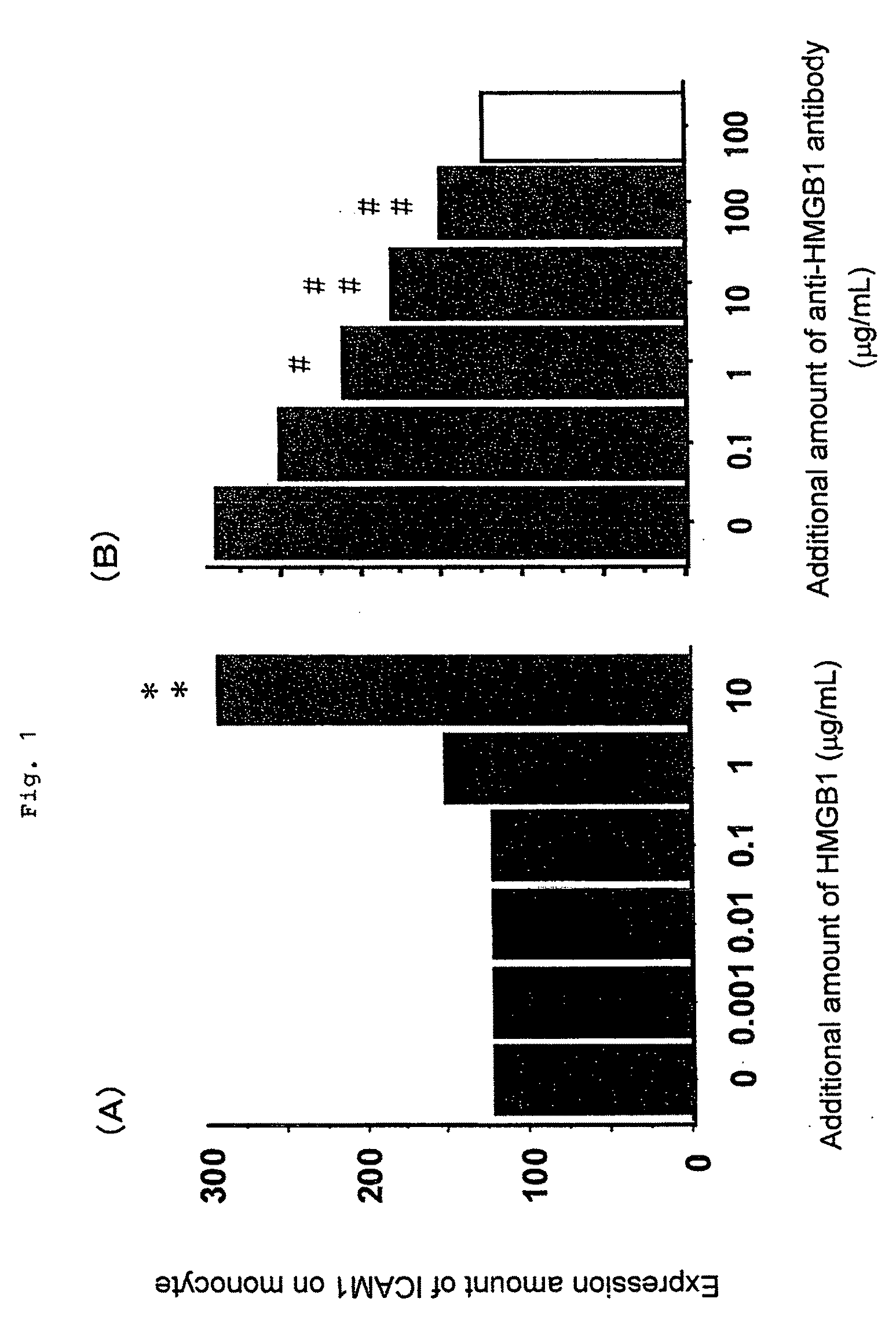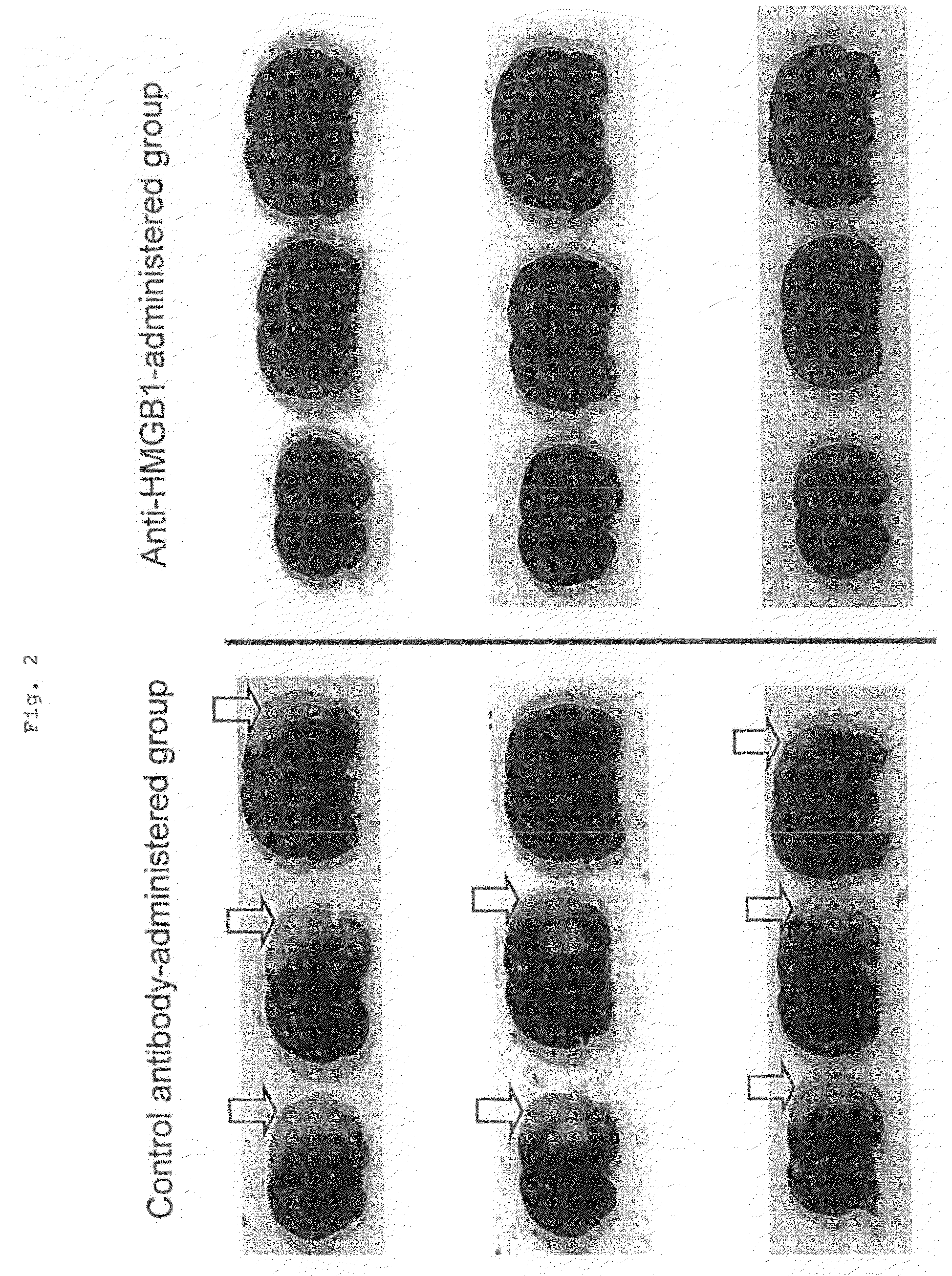Cerebral Infarction Suppressant
a technology for cerebral infarction and suppressant, which is applied in the direction of antibody medical ingredients, drug compositions, peptides, etc., can solve the problems of limited efficacy and achieve the effect of effective suppression of brain tissue necrosis, low genotoxic side effects, and low side effects
- Summary
- Abstract
- Description
- Claims
- Application Information
AI Technical Summary
Benefits of technology
Problems solved by technology
Method used
Image
Examples
example 1
Preparation of Anti-HMGB1 Monoclonal Antibody
(a) Immunization of Rat
[0035]Into a 2 ml-glass syringe, was taken 1 mg / mL of a commercially available mixture of bovine thymus-derived HMGB1 and HMGB2 (manufactured by Wako Pure Chemical Industries, Ltd., code No. 080-070741), and an equivalent volume of a complete Freund's adjuvant was taken into another 2 mL-glass syringe. These syringes were connected with a connecting tube. The mixture and the adjuvant were gradually kneaded through the connecting tube to obtain an emulsion. Each 0.1 mL of the obtained emulsion at a total of 0.2 mL was injected to a rat anesthetized with sevoflurane in a hind limb footpads. After 2 weeks, blood was probatively taken from jugular, and the increase of antibody titer was confirmed. Then, an enlarged iliac lymph node was sterilely taken out 5 weeks after the injection administration. From the two lymph nodes obtained, about 6×107 cells could be recovered.
[0036]The iliac lymph no...
example 2
[0038]The neutralization activity of the anti-HMGB1 monoclonal antibody prepared in Example 1 was tested.
[0039]First, 1×106 / mL peripheral blood mononuclear cells were prepared from peripheral blood of a healthy person by a conventional method, and were cultured for 24 hours in a basal medium for culturing an animal cell containing 10% bovine fetal serum (manufactured by Sigma, RPMI1640). Then, bovine HMGB1 purified from a bovine thymus-derived HMGB1 / 2 mixture manufactured by Wako Pure Chemical Industries, Ltd. was added to the medium at a concentration of 0.001 to 10 μg / mL to stimulate the monocytes. Twenty four hours after addition of HMGB1, the cells were collected, and an expression amount of ICAM-1 (intercellular adhesion molecule-1) expressed on the monocytes with HMGB1 was quantitated by a fluorescent antibody method (FACS method). Results are shown in FIG. 1(A). In FIG. 1(A), “**” indicates the case where there was a significant difference at p<0.01 by t-test as compared with...
example 3
[0041]Fifteen male Wistar rats weighing about 300 g were divided into an anti-HMGB1 monoclonal antibody-administered group of 7 animals and a control antibody-administered group of 8 animals. These rats were anesthetized with a gas mixture of 2% halothane and 50% laughing gas, and kept under spontaneous breathing. Subsequently, a median incision was made in the neck of the rat placed on its back, and the right common carotid artery was exposed. After an intraperitoneal injection of 100 units of heparin, the root of the right middle cerebral artery was occluded by inserting 4.0 nylon thread coated with silicone into the right internal carotid artery from the bifurcation of the internal and external carotid arteries. The tip of the nylon thread was placed 18 mm from the bifurcation. After suture of the incision of the skin, the rats were allowed to recover from anesthesia. During surgery, an electronic thermometer was inserted into the rectum, and the rectum temperature was maintained...
PUM
| Property | Measurement | Unit |
|---|---|---|
| concentration | aaaaa | aaaaa |
| time | aaaaa | aaaaa |
| time | aaaaa | aaaaa |
Abstract
Description
Claims
Application Information
 Login to View More
Login to View More - R&D
- Intellectual Property
- Life Sciences
- Materials
- Tech Scout
- Unparalleled Data Quality
- Higher Quality Content
- 60% Fewer Hallucinations
Browse by: Latest US Patents, China's latest patents, Technical Efficacy Thesaurus, Application Domain, Technology Topic, Popular Technical Reports.
© 2025 PatSnap. All rights reserved.Legal|Privacy policy|Modern Slavery Act Transparency Statement|Sitemap|About US| Contact US: help@patsnap.com



